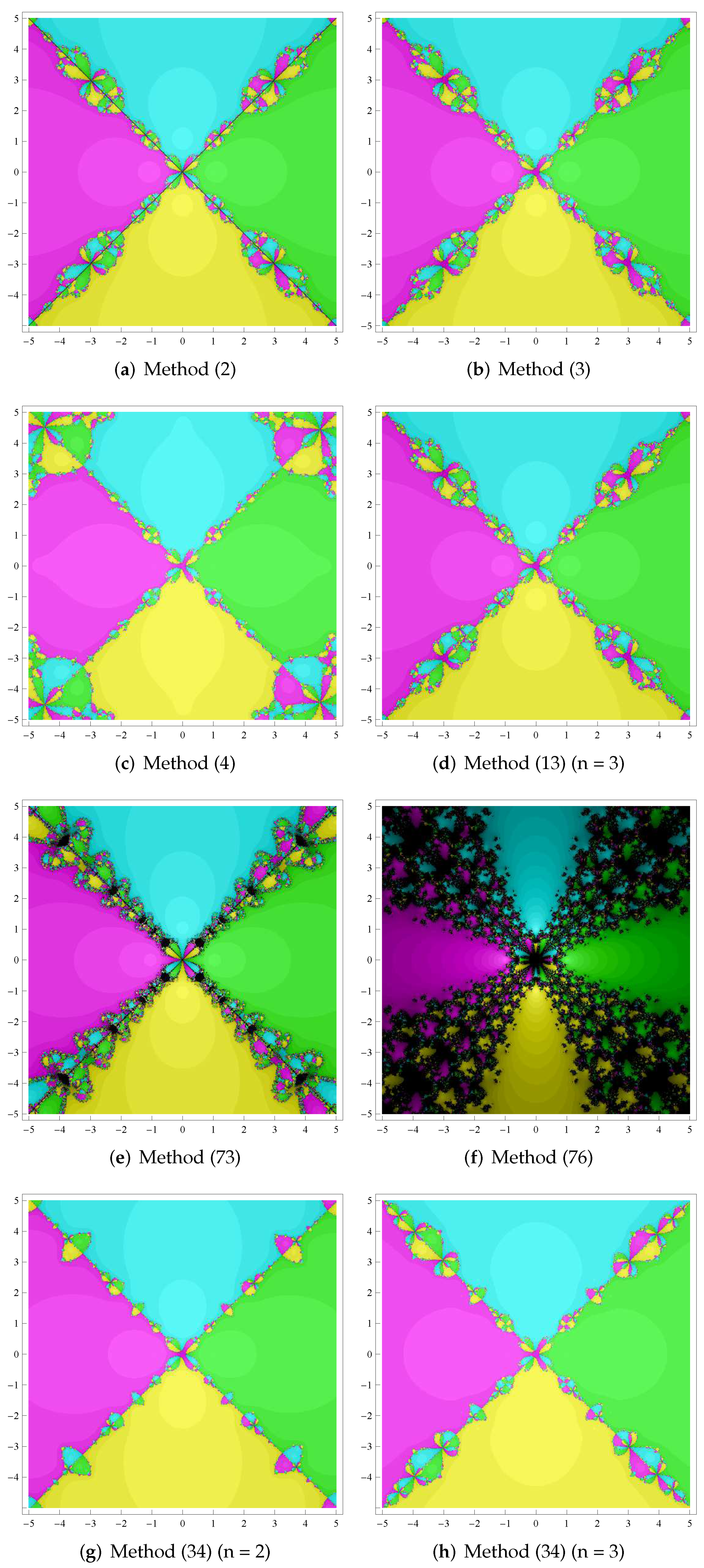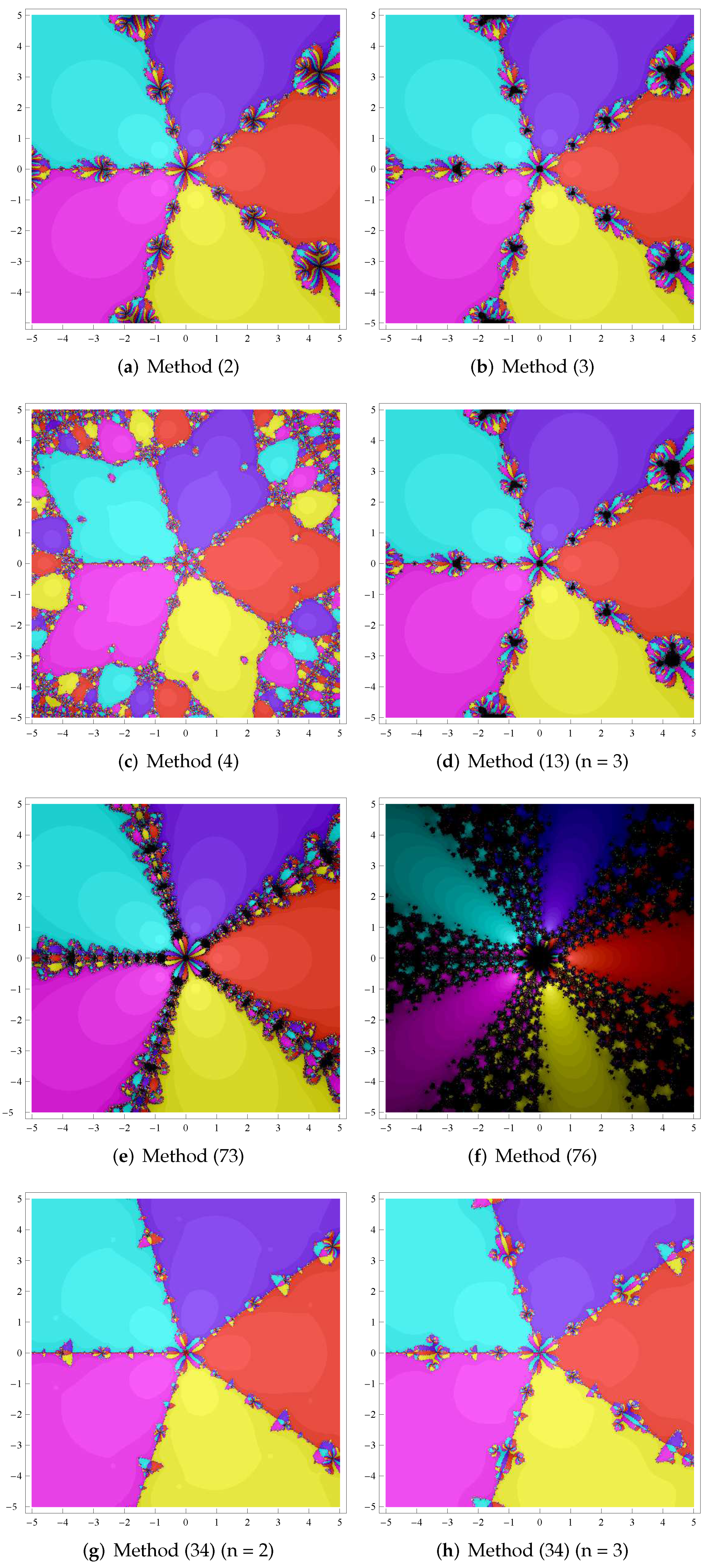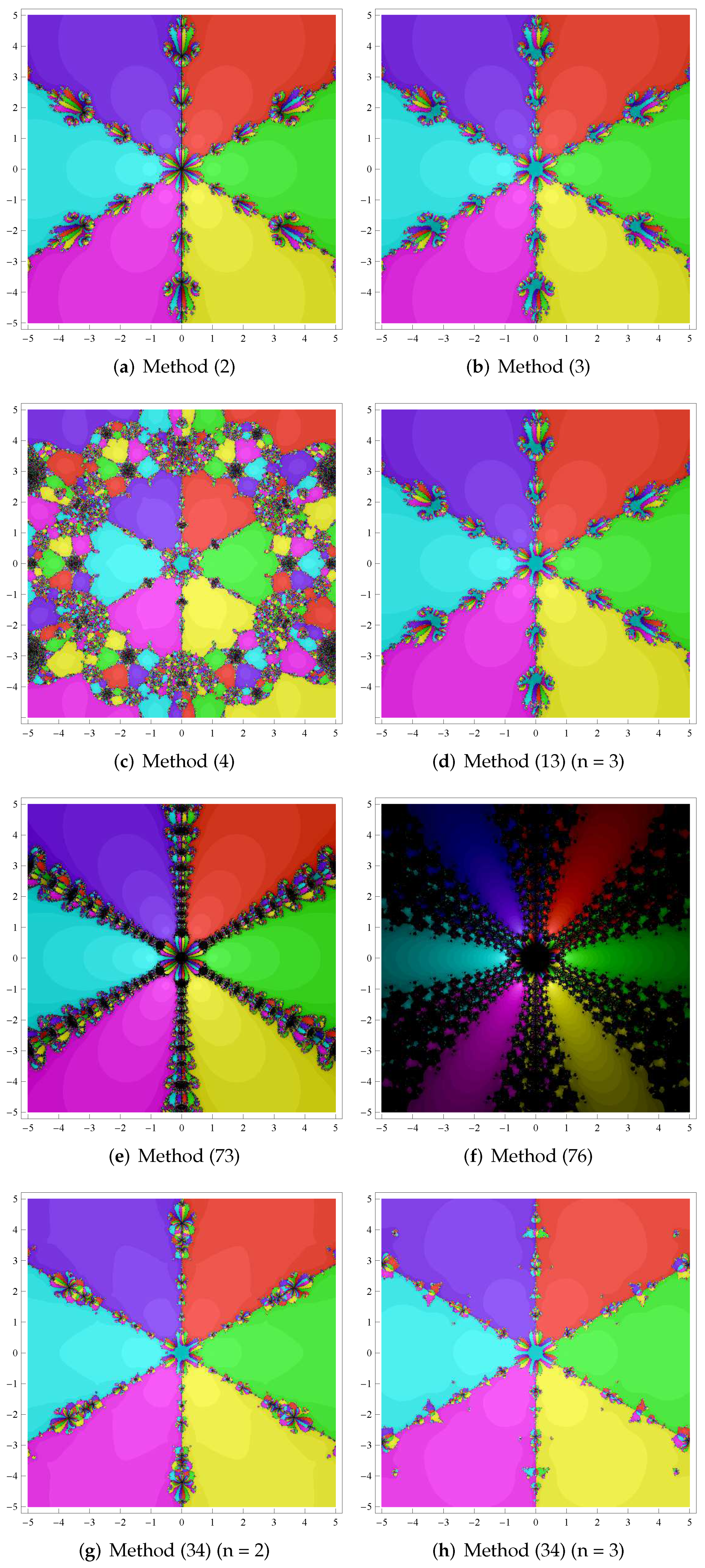A Novel n-Point Newton-Type Root-Finding Method of High Computational Efficiency
Abstract
:1. Introduction
2. The n-Parameter n-Point Newton-Type Method with Optimal Order 2n
3. A General -Point Newton-Type Multipoint Iterative Method with Memory
4. Basins of Attraction
5. Numerical Examples
6. Conclusions
Funding
Institutional Review Board Statement
Informed Consent Statement
Data Availability Statement
Conflicts of Interest
References
- Traub, J.F. Iterative Methods for the Solution of Equations; Prentice-Hall: Hoboken, NJ, USA, 1964. [Google Scholar]
- Petković, M.S.; Neta, B.; Petković, L.; Džunić, J. Multipoint Methods for Solving Nonlinear Equtions; Academic Press: Boston, MA, USA, 2013. [Google Scholar]
- Chun, C. Some fourth-order iterative methods for solving nonlinear equations. Appl. Math. Comput. 2008, 195, 454–459. [Google Scholar] [CrossRef]
- Soleymani, F.; Sharifi, M.; Mousavi, B.S. An improvement of Ostrowski’s and King’s techniques with optimal convergence order eight. J. Optim. Theo. Appl. 2012, 153, 225–236. [Google Scholar] [CrossRef]
- Geum, Y.H.; Kim, Y.I. A uniparametric family of three-step eighth-order multipoint iterative methods for simple roots. Appl. Math. Lett. 2011, 24, 929–935. [Google Scholar] [CrossRef]
- Petković, M.S. On a general class of multipoint root-finding methods of high computational efficiency. Siam. J. Numer. Anal. 2010, 47, 4402–4414. [Google Scholar] [CrossRef]
- Ren, H.; Wu, Q.; Bi, W. A class of two-step Steffensen type methods with fourth-order convergence. Appl. Math. Comput. 2009, 209, 206–210. [Google Scholar] [CrossRef]
- Wang, X.; Zhu, M. Two Iterative Methods with Memory Constructed by the Method of Inverse Interpolation and Their Dynamics. Mathematics 2020, 8, 1080. [Google Scholar] [CrossRef]
- Sharma, J.R.; Sharma, R. A new family of modified Ostrowski’s methods with accelerated eighth order convergence. Numer. Algor. 2010, 54, 445–458. [Google Scholar] [CrossRef]
- Chun, C.; Neta, B. Certain improvements of Newton’s method with fourth-order convergence. Appl. Math. Comput. 2009, 215, 821–828. [Google Scholar] [CrossRef] [Green Version]
- Neta, B.; Petković, M.S. Construction of optimal order nonlinear solvers usnig inverse interplation. Appl. Math. Comput. 2010, 217, 2448–2455. [Google Scholar]
- Petković, M.S.; Džunić, J.; Neta, B. Interpolatory multipoint methods with memory for solving nonlinear equations. Appl. Math. Comput. 2011, 218, 2533–2541. [Google Scholar] [CrossRef]
- Petković, L.D.; Petković, M.S.; Džunić, J. A class of three-point root-solvers of optimal order of convergence. Appl. Math. Comput. 2010, 216, 671–676. [Google Scholar] [CrossRef]
- Kung, H.T.; Traub, J.F. Optimal order of one-point and multipoint iteration. J. Assoc. Comput. Math. 1974, 21, 634–651. [Google Scholar] [CrossRef]
- Zheng, Q.; Li, J.; Huang, F. An optimal Steffensen-type family for solving nonlinear equations. Appl. Math. Comput. 2011, 217, 9592–9597. [Google Scholar] [CrossRef]
- Džunić, J.; Petković, M.S. On generalized biparametric multipoint root finding methods with memory. J. Comput. Appl. Math. 2014, 255, 362–375. [Google Scholar] [CrossRef]
- Wang, X.; Zhang, T. Efficient n-point iterative methods with memory for solving nonlinear equations. Numer. Algor. 2015, 70, 357–375. [Google Scholar] [CrossRef]
- Petković, M.S. Remarks on “On a general class of multipoint root-finding methods of high computational efficiency”. Siam. J. Numer. Anal. 2011, 49, 1317–1319. [Google Scholar]
- Cordero, A.; Torregrosa, J.R.; Triguero-Navarro, P. A general optimal iterative scheme with arbitrary order of convergence. Symmetry 2021, 13, 884. [Google Scholar] [CrossRef]
- Wang, X.; Qin, Y.; Qian, W.; Zhang, S.; Fan, X. A family of newton type iterative methods for solving nonlinear equations. Algorithms 2015, 8, 786–798. [Google Scholar] [CrossRef] [Green Version]
- Jelley, C.T. Solving Nonlinear Equations with Newton’s Method; SIAM: Philadelphia, PA, USA, 2003. [Google Scholar]
- Ortega, J.M.; Rheinbolt, W.C. Iterative Solution of Nonlinear Equations in Several Variables; Academic Press: New York, NY, USA, 1970. [Google Scholar]
- Wang, X.; Chen, X. The Dynamical Analysis of a Biparametric Family of Six-Order Ostrowski-Type Method under the Möbius Conjugacy Map. Fractal Fract. 2022, 6, 174. [Google Scholar] [CrossRef]
- Wang, X.; Chen, X. Derivative-Free Kurchatov-Type Accelerating Iterative Method for Solving Nonlinear Systems: Dynamics and Applications. Fractal Fract. 2022, 6, 59. [Google Scholar] [CrossRef]
- Sharma, D.; Argyros, I.K.; Parhi, S.K.; Sunanda, S.K. Local Convergence and Dynamical Analysis of a Third and Fourth Order Class of Equation Solvers. Fractal Fract. 2021, 5, 27. [Google Scholar] [CrossRef]
- Behl, R.; Cordero, A.; Torregrosa, J.R. High order family of multivariate iterative methods: Convergence and stability. J. Comput. Appl. Math. 2020, 405, 113053. [Google Scholar] [CrossRef]
- Neta, B.; Scott, M.; Chun, C. Basin attrators for various methods for multiple roots. Appl. Math. Comput. 2012, 218, 5043–5066. [Google Scholar]
- Argyros, I.K.; Magreñán, Á.A. Iterative Methods and their Dynamics with Applications: A Contemporary Study; CRC Press: Boca Raton, FL, USA, 2017. [Google Scholar]
- Galilea, V.; Gutiéreez, J.M. A Characterization of the Dynamics of Schröder’s Method for Polynomials with Two Roots. Fractal Fract. 2021, 5, 25. [Google Scholar] [CrossRef]
- Susanto, H.; Karjanto, N. Newton’s method’s basins of attraction revisited. Appl. Math. Comput. 2009, 215, 1084–1090. [Google Scholar] [CrossRef] [Green Version]
- Mallawi, F.O.; Behl, R.; Maroju, P. On Global Convergence of Third-Order Chebyshev-Type Method under General Continuity Conditions. Fractal Fract. 2022, 6, 46. [Google Scholar] [CrossRef]
- Ardelean, G. A comparison between iterative methods by using the basins of attraction. Appl. Math. Comput. 2011, 218, 88–95. [Google Scholar] [CrossRef]
- Wang, X. A new accelerating technique applied to a variant of Cordero-Torregrosa method. J. Comput. Appl. Math. 2018, 330, 695–709. [Google Scholar] [CrossRef]
- Cordero, A.; Torregrosa, J.R. Variants of Newton’s Method using fifth-order quadrature foumulas. Appl. Math. Comput. 2007, 190, 686–698. [Google Scholar]





| Methods | (2) | (3) | (4) | (13) (n = 3) | (73) | (76) | (34) (n = 2) | (34) (n = 3) |
|---|---|---|---|---|---|---|---|---|
| POP | 99.80% | 100% | 100% | 100% | 99.80% | 96.02% | 100% | 100% |
| ANI | 2.2781 | 2.2415 | 1.1430 | 2.2233 | 3.4107 | 11.401 | 1.8806 | 1.1371 |
| Methods | (2) | (3) | (4) | (13) (n = 3) | (73) | (76) | (34) (n = 2) | (34) (n = 3) |
|---|---|---|---|---|---|---|---|---|
| POP | 100% | 99.99% | 100% | 100% | 99.62% | 77.53% | 100% | 100% |
| ANI | 2.6354 | 2.6416 | 1.3591 | 2.6386 | 4.4523 | 15.669 | 2.1994 | 1.3430 |
| Methods | (2) | (3) | (4) | (13) (n = 3) | (73) | (76) | (34) (n = 2) | (34) (n = 3) |
|---|---|---|---|---|---|---|---|---|
| POP | 99.60% | 100% | 100% | 100% | 97.10% | 63.42% | 100% | 100% |
| ANI | 3.5018 | 3.4208 | 2.1952 | 3.4200 | 6.3275 | 18.667 | 2.5931 | 1.9959 |
| Methods | (2) | (3) | (4) | (13) (n = 3) | (73) | (76) | (34) (n = 2) | (34) (n = 3) |
|---|---|---|---|---|---|---|---|---|
| POP | 99.83% | 98.34% | 99.98% | 98.35% | 95.75% | 61.57% | 99.99% | 100% |
| ANI | 4.2132 | 4.3115 | 3.5273 | 4.3119 | 6.9659 | 19.920 | 2.7746 | 2.2169 |
| Methods | (2) | (3) | (4) | (13) (n = 3) | (73) | (76) | (34) (n = 2) | (34) (n = 3) |
|---|---|---|---|---|---|---|---|---|
| POP | 99.60% | 99.98% | 98.09% | 99.98% | 94.27% | 53.35% | 99.92% | 99.99% |
| ANI | 4.6530 | 4.5337 | 5.1056 | 4.5347 | 7.8804 | 21.428 | 3.3563 | 2.4707 |
| Method | ACOC | ||||
|---|---|---|---|---|---|
| (2) n = 2 | 0.51126 | 0.97721 | 0.13043 | 0.41401 | 4.0000003 |
| (3) n = 2 | 0.54528 | 0.13358 | 0.48098 | 0.80864 | 4.0000000 |
| (13) n = 2 | 0.52925 | 0.11597 | 0.26735 | 0.75510 | 4.0000000 |
| (73) | 0.44088 | 0.64006 | 0.44087 | 0.32433 | 4.5599449 |
| (76) | 0.27347 | 0.29224 | 0.13268 | 0.60206 | 4.2386945 |
| (34) n = 2 | 0.52925 | 0.21668 | 0.48274 | 0.86928 | 5.7024880 |
| (2) n = 3 | 0.40835 | 0.24321 | 0.38502 | 8.0008692 | |
| (3) n = 3 | 0.45332 | 0.61330 | 0.68830 | 8.0000000 | |
| (13) n = 3 | 0.44026 | 0.47630 | 0.89387 | 8.0000000 | |
| (4) n = 3 | 0.45332 | 0.14236 | 0.62560 | 10.004219 | |
| (34) n = 3 | 0.44026 | 0.29405 | 0.86439 | 11.619740 |
| Method | ACOC | ||||
|---|---|---|---|---|---|
| (2) n = 2 | 0.11793 | 0.84626 | 0.22447 | 0.11110 | 4.0000000 |
| (3) n = 2 | 0.12130 | 0.97704 | 0.41138 | 0.12928 | 4.0000000 |
| (13) n = 2 | 0.12145 | 0.98370 | 0.42339 | 0.14529 | 4.0000000 |
| (73) | 0.62678 | 0.88468 | 0.18867 | 0.41780 | 4.5599373 |
| (76) | 0.31113 | 0.69098 | 0.29916 | 0.23336 | 4.2360780 |
| (34) n = 2 | 0.12145 | 0.42142 | 0.33957 | 0.70177 | 5.6961912 |
| (2) n = 3 | 0.15535 | 0.72017 | 0.15361 | 8.0000000 | |
| (3) n = 3 | 0.16390 | 0.11729 | 0.80666 | 8.0000000 | |
| (13) n = 3 | 0.16405 | 0.11831 | 0.86592 | 8.0000000 | |
| (4) n = 3 | 0.16390 | 0.46896 | 0.17682 | 9.9998487 | |
| (34) n = 3 | 0.16405 | 0.65259 | 0.93155 | 11.725876 |
| Method | ACOC | ||||
|---|---|---|---|---|---|
| (2) n = 2 | 0.42633 | 0.10988 | 0.48611 | 0.18620 | 4.0000000 |
| (3) n = 2 | 0.43209 | 0.11749 | 0.64401 | 0.58130 | 4.0000000 |
| (13) n = 2 | 0.43241 | 0.11792 | 0.65398 | 0.61858 | 4.0000000 |
| (73) | 0.59903 | 0.25674 | 0.13907 | 0.35294 | 4.5597146 |
| (76) | 0.10103 | 0.69855 | 0.23785 | 0.22107 | 4.2381255 |
| (34) n = 2 | 0.43241 | 0.48374 | 0.18668 | 0.20222 | 5.6801734 |
| (2) n = 3 | 0.27207 | 0.50023 | 0.65317 | 8.0000000 | |
| (3) n = 3 | 0.27947 | 0.63668 | 0.46203 | 8.0000000 | |
| (13) n = 3 | 0.27977 | 0.64293 | 0.50004 | 8.0000000 | |
| (4)n=3 | 0.27947 | 0.14545 | 0.21179 | 10.000013 | |
| (34) n = 3 | 0.27977 | 0.19008 | 0.75443 | 11.920006 |
| Method | ACOC | ||||
|---|---|---|---|---|---|
| (2) n = 2 | 0.45791 | 0.29033 | 0.47507 | 0.34058 | 4.0000000 |
| (3) n = 2 | 0.46989 | 0.32946 | 0.80651 | 0.28961 | 4.0000000 |
| (13) n = 2 | 0.47013 | 0.33026 | 0.81472 | 0.30172 | 4.0000000 |
| (73) | 0.21843 | 0.71702 | 0.63014 | 0.30506 | 4.5595182 |
| (76) | 0.13208 | 0.35938 | 0.23138 | 0.10762 | 4.2415301 |
| (34) n = 2 | 0.47013 | 0.78035 | 0.22231 | 0.33152 | 5.6871333 |
| (2) n = 3 | 0.16926 | 0.22742 | 0.24157 | 8.0000000 | |
| (3) n = 3 | 0.17852 | 0.36590 | 0.11400 | 8.0000000 | |
| (13) n = 3 | 0.17864 | 0.36802 | 0.11943 | 7.9999986 | |
| (4) n = 3 | 0.17852 | 0.56501 | 0.55091 | 10.115357 | |
| (34) n = 3 | 0.17864 | 0.38690 | 0.18244 | 11.873804 |
Publisher’s Note: MDPI stays neutral with regard to jurisdictional claims in published maps and institutional affiliations. |
© 2022 by the author. Licensee MDPI, Basel, Switzerland. This article is an open access article distributed under the terms and conditions of the Creative Commons Attribution (CC BY) license (https://creativecommons.org/licenses/by/4.0/).
Share and Cite
Wang, X. A Novel n-Point Newton-Type Root-Finding Method of High Computational Efficiency. Mathematics 2022, 10, 1144. https://doi.org/10.3390/math10071144
Wang X. A Novel n-Point Newton-Type Root-Finding Method of High Computational Efficiency. Mathematics. 2022; 10(7):1144. https://doi.org/10.3390/math10071144
Chicago/Turabian StyleWang, Xiaofeng. 2022. "A Novel n-Point Newton-Type Root-Finding Method of High Computational Efficiency" Mathematics 10, no. 7: 1144. https://doi.org/10.3390/math10071144






